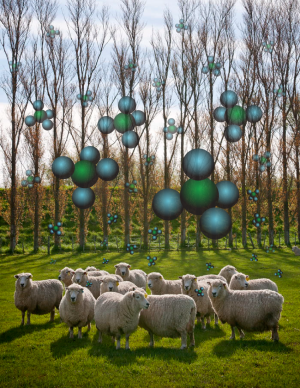Study reveals livestock gut microbes contributing to greenhouse gas emissions

"Increased to levels unprecedented" is how the Intergovernmental Panel on Climate Change (IPCC) described the rise of carbon dioxide, methane and nitrous oxide emissions in their report on the physical science basis of climate change in 2013. According to the US Environmental Protection Agency (EPA), the atmospheric concentration of methane, a greenhouse gas some 28 times more potent than carbon dioxide has been steadily growing since the 18th century and has now increased by 50 percent compared to pre-industrial levels, exceeding 1,800 parts per billion.
The EPA attributes one-fifth of methane emissions to livestock such as cattle, sheep and other ruminants. In fact, ruminant livestock are the single largest source of methane emissions, and in a country like New Zealand (NZ), where the sheep outnumber people 7 to 1, that's a big deal. However, not all ruminants are equal when it comes to greenhouse gas emissions. It turns out that the amount of methane produced varies substantially across individual animals of the same ruminant species. To find out why this is so, a team of researchers led by the U.S. Department of Energy Joint Genome Institute (DOE JGI) deployed high throughput DNA sequencing and specialized analysis techniques to explore the contents of the rumens of sheep in collaboration with NZ's AgResearch Limited to see what role ruminant "microbiomes" (the microbes living in the rumen) play in this process. The study was published online June 6, 2014 in Genome Research.
"We wanted to understand why some sheep produce a lot and some produce little methane," said DOE JGI Director Eddy Rubin. "The study shows that it is purely the microbiota responsible for the difference."
To learn why the amount of methane that ruminants produce varies, the researchers took advantage of a large sheep screening and breeding program in NZ that aims to breed low methane-emitting ruminants without impacting other traits such as reproduction and wool and meat quality. The team measured the methane yields from a cohort of 22 sheep, and from this group, they selected four sheep with the lowest methane emissions, four sheep with the highest emissions and two sheep with intermediate emission levels. Rumen metagenome DNA samples collected on two occasions from the 10 sheep were sequenced at the DOE JGI, generating 50 billion bases of data each.
"The deep sequencing study contributes to this breeding program by defining the microbial contribution to the methane trait, which can be used in addition to methane measurements to assist in animal selection," said senior scientist Graeme Attwood of AgResearch Limited, a senior author on the paper.
The team then checked to see if there was a correlation between the proportions of methanogens in the eight sheep with the highest and lowest recorded methane emissions. In sheep with low methane emissions, they found elevated levels of one particular species of methanogen (Methanosphaera) while sheep with high methane emissions had elevated levels of another group of methanogens (Methanobrevibacter gottschalkii). Exploring further, the team then identified a methane-producing pathway and three variants of a gene encoding an important methane-forming reaction that were involved in elevated methane yields. While the overall changes to the methane-producing microbial community structure and methanogen abundance across sheep were rather subtle, the team reported that the expression levels of genes involved in methane production varied more substantially across sheep, suggesting differential gene regulation, perhaps controlled by hydrogen concentration in the rumen or by variations in the dwell time of their feed.
"It's not so much the actual composition of the microbiome that determines emission—which conventional wisdom would suggest—but mostly transcriptional regulation within the existing microbes that makes the difference, which is a concept that is relatively new in metagenomic studies," Rubin said. The team's findings suggest new possible targets for mitigating methane emissions at the microbiome level.
Screening and breeding for low-methane producing sheep is still underway, and importantly, low-methane lines then need to be tested for stability of the trait, as well as the absence of any impacts on fertility or meat or wool production. Moreover, as Attwood notes, "there needs to be an incentive for farmers to incorporate low methane animals into their flocks, that is, achieving better performance with the low methane animals or being able to claim carbon credits. If everything went well you could expect introduction of the low methane trait to begin in three years, and for there to be slow but incremental changes to the sheep industry in subsequent years."
Journal information: Genome Research
Provided by DOE/Joint Genome Institute



















